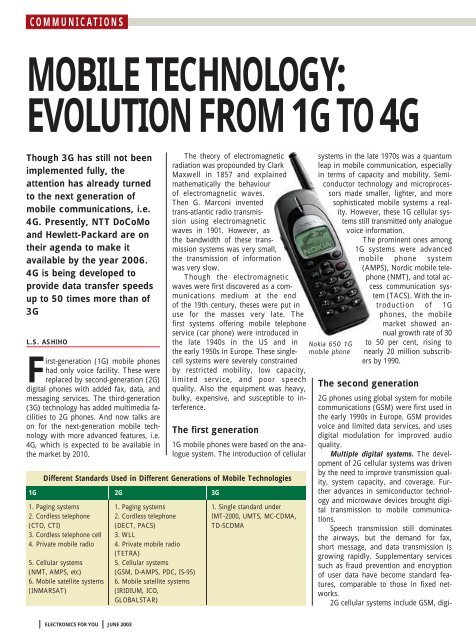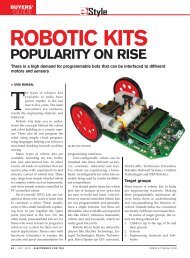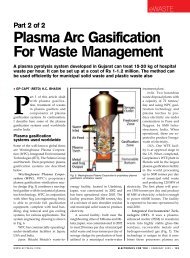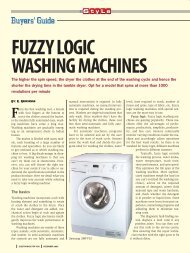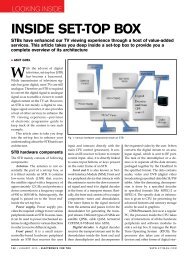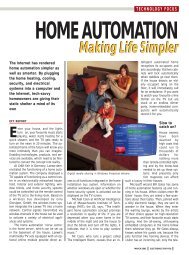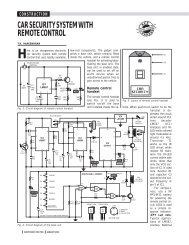mobile technology: evolution from 1g to 4g - Electronics For You
mobile technology: evolution from 1g to 4g - Electronics For You
mobile technology: evolution from 1g to 4g - Electronics For You
Create successful ePaper yourself
Turn your PDF publications into a flip-book with our unique Google optimized e-Paper software.
COMMUNICATIONS<br />
COMMUNICATIONS<br />
MOBILE TECHNOLOGY:<br />
EVOLUTION FROM 1G TO 4G<br />
Though 3G has still not been<br />
implemented fully, the<br />
attention has already turned<br />
<strong>to</strong> the next generation of<br />
<strong>mobile</strong> communications, i.e.<br />
4G. Presently, NTT DoCoMo<br />
and Hewlett-Packard are on<br />
their agenda <strong>to</strong> make it<br />
available by the year 2006.<br />
4G is being developed <strong>to</strong><br />
provide data transfer speeds<br />
up <strong>to</strong> 50 times more than of<br />
3G<br />
L.S. ASHIHO<br />
First-generation (1G) <strong>mobile</strong> phones<br />
had only voice facility. These were<br />
replaced by second-generation (2G)<br />
digital phones with added fax, data, and<br />
messaging services. The third-generation<br />
(3G) <strong>technology</strong> has added multimedia facilities<br />
<strong>to</strong> 2G phones. And now talks are<br />
on for the next-generation <strong>mobile</strong> <strong>technology</strong><br />
with more advanced features, i.e.<br />
4G, which is expected <strong>to</strong> be available in<br />
the market by 2010.<br />
ELECTRONICS FOR YOU JUNE 2003<br />
The theory of electromagnetic<br />
radiation was propounded by Clark<br />
Maxwell in 1857 and explained<br />
mathematically the behaviour<br />
of electromagnetic waves.<br />
Then G. Marconi invented<br />
trans-atlantic radio transmission<br />
using electromagnetic<br />
waves in 1901. However, as<br />
the bandwidth of these transmission<br />
systems was very small,<br />
the transmission of information<br />
was very slow.<br />
Though the electromagnetic<br />
waves were first discovered as a communications<br />
medium at the end<br />
of the 19th century, theses were put in<br />
use for the masses very late. The<br />
first systems offering <strong>mobile</strong> telephone<br />
service (car phone) were introduced in<br />
the late 1940s in the US and in<br />
the early 1950s in Europe. These singlecell<br />
systems were severely constrained<br />
by restricted mobility, low capacity,<br />
limited service, and poor speech<br />
quality. Also the equipment was heavy,<br />
bulky, expensive, and susceptible <strong>to</strong> interference.<br />
The first generation<br />
1G <strong>mobile</strong> phones were based on the analogue<br />
system. The introduction of cellular<br />
Different Standards Used in Different Generations of Mobile Technologies<br />
1G 2G 3G<br />
1. Paging systems 1. Paging systems 1. Single standard under<br />
2. Cordless telephone 2. Cordless telephone IMT-2000, UMTS, MC-CDMA,<br />
(CTO, CTI) (DECT, PACS) TD-SCDMA<br />
3. Cordless telephone cell 3. WLL<br />
4. Private <strong>mobile</strong> radio 4. Private <strong>mobile</strong> radio<br />
(TETRA)<br />
5. Cellular systems 5. Cellular systems<br />
(NMT, AMPS, etc) (GSM, D-AMPS, PDC, IS-95)<br />
6. Mobile satellite systems 6. Mobile satellite systems<br />
(INMARSAT) (IRIDIUM, ICO,<br />
GLOBALSTAR)<br />
systems in the late 1970s was a quantum<br />
leap in <strong>mobile</strong> communication, especially<br />
in terms of capacity and mobility. Semiconduc<strong>to</strong>r<br />
<strong>technology</strong> and microprocessors<br />
made smaller, lighter, and more<br />
sophisticated <strong>mobile</strong> systems a reality.<br />
However, these 1G cellular systems<br />
still transmitted only analogue<br />
voice information.<br />
The prominent ones among<br />
1G systems were advanced<br />
<strong>mobile</strong> phone system<br />
(AMPS), Nordic <strong>mobile</strong> telephone<br />
(NMT), and <strong>to</strong>tal access<br />
communication system<br />
(TACS). With the introduction<br />
of 1G<br />
phones, the <strong>mobile</strong><br />
market showed annual<br />
growth rate of 30<br />
Nokia 650 1G<br />
<strong>mobile</strong> phone<br />
<strong>to</strong> 50 per cent, rising <strong>to</strong><br />
nearly 20 million subscribers<br />
by 1990.<br />
The second generation<br />
2G phones using global system for <strong>mobile</strong><br />
communications (GSM) were first used in<br />
the early 1990s in Europe. GSM provides<br />
voice and limited data services, and uses<br />
digital modulation for improved audio<br />
quality.<br />
Multiple digital systems. The development<br />
of 2G cellular systems was driven<br />
by the need <strong>to</strong> improve transmission quality,<br />
system capacity, and coverage. Further<br />
advances in semiconduc<strong>to</strong>r <strong>technology</strong><br />
and microwave devices brought digital<br />
transmission <strong>to</strong> <strong>mobile</strong> communications.<br />
Speech transmission still dominates<br />
the airways, but the demand for fax,<br />
short message, and data transmission is<br />
growing rapidly. Supplementary services<br />
such as fraud prevention and encryption<br />
of user data have become standard features,<br />
comparable <strong>to</strong> those in fixed networks.<br />
2G cellular systems include GSM, digi-
tal AMPS (D-AMPS), code-division multiple<br />
access (CDMA), and personal digital<br />
communication (PDC).<br />
Today, multiple IG and 2G standards<br />
are used in worldwide <strong>mobile</strong> communications.<br />
Different standards serve different<br />
applications (paging, cordless telephony,<br />
wireless local loop, private <strong>mobile</strong><br />
radio, cellular telephony, and <strong>mobile</strong> satellite<br />
communication) with different levels<br />
of mobility, capability, and service area.<br />
Many standards are used only in one country<br />
or region, and are incompatible.<br />
GSM is the most successful family of<br />
cellular standards. It includes GSM900,<br />
GSM-railway (GSM-R), GSM1800,<br />
GSM1900, and GSM400. GSM supports<br />
around 250 million of the world’s 450 million<br />
cellular subscribers, with international<br />
roaming in approximately 140 countries<br />
and 400 networks.<br />
The core network. This network links<br />
<strong>to</strong>gether all the cells in<strong>to</strong> a single network,<br />
coordinates resources <strong>to</strong> hand over<br />
your call <strong>from</strong> one cell <strong>to</strong> another as you<br />
move, discovers where you are so that<br />
you can receive incoming calls, links <strong>to</strong><br />
the fixed network so that you can reach<br />
fixed-line phones, and communicates with<br />
roaming partners. <strong>You</strong> can use your phone<br />
on other network links <strong>to</strong> the Internet, so<br />
you can reach Web servers and corporate<br />
systems worldwide <strong>to</strong> control and deliver<br />
services depending on your subscription<br />
profile.<br />
The 2G architecture. The existing <strong>mobile</strong><br />
network consists of the radio access<br />
LG’s IMT-2000 concept phone<br />
network (comprising cells and<br />
backhaul communications)<br />
and the core network<br />
(comprising trunks,<br />
switches, and servers).<br />
Mobile switching centres<br />
(MSCs) are intelligent<br />
servers and the whole network<br />
is data-driven, using<br />
subscription and authentication<br />
information held<br />
in the home location register<br />
(HLR) and authentication<br />
centre (AuC).<br />
The standard services<br />
include circuit-switched<br />
voice, fax, and data, as<br />
well as voicemail and<br />
voicemail notification. Additional<br />
services include<br />
wireless application pro<strong>to</strong>col<br />
(WAP), high-speed circuit-switched<br />
data (HSCSD),<br />
<strong>mobile</strong> location services<br />
(MLS), and cell broadcast.<br />
<strong>You</strong> can change <strong>to</strong> a new opera<strong>to</strong>r<br />
keeping your old phone<br />
number.<br />
2.5G<br />
Siemens S57 2.5G<br />
GPRS phone<br />
The <strong>mobile</strong> <strong>technology</strong> using general<br />
packet radio service (GPRS) standard has<br />
been termed as 2.5G. 2.5G systems enhance<br />
the data capacity of GSM and mitigate<br />
some of its limitations. GPRS adds<br />
packet-switched capa- bilities <strong>to</strong> existing<br />
GSM<br />
and TDMA networks.<br />
Working<br />
on the basis of emails,<br />
it sends text<br />
and graphics-rich<br />
data as packets at very<br />
fast speed.<br />
The circuit-switched<br />
<strong>technology</strong> has a long and<br />
successful his<strong>to</strong>ry but it<br />
is inefficient for<br />
short data transactions<br />
and always-on<br />
service. The packetswitched<br />
<strong>technology</strong><br />
has grown in importance<br />
with the rise of the Internet<br />
and Internet pro<strong>to</strong>col (IP). But<br />
as IP <strong>to</strong>o has its own weaknesses,<br />
circuit-switched services<br />
are not going <strong>to</strong> disappear.<br />
Transmission control pro<strong>to</strong>col<br />
(TCP) provides a virtual end-<strong>to</strong>-<br />
JUNE 2003<br />
COMMUNICATIONS<br />
end connection for reliability.<br />
Although Telnet is still<br />
used as a standard pro<strong>to</strong>col<br />
for remote access <strong>to</strong><br />
computer hosts, the main<br />
pro<strong>to</strong>cols in use <strong>to</strong>day are<br />
HTTP for Web servers,<br />
SMTP for e-mail, and<br />
SNMP for network management.<br />
The GPRS (2.5G) core<br />
network and service characteristics.<br />
Although GPRS<br />
is an extension <strong>to</strong> the radio<br />
access network, it requires<br />
whole new packetbased<br />
IP data links, servers,<br />
and gateways in the<br />
core network. Thus GPRS<br />
adds several new components<br />
besides changing the<br />
existing GSM or TDMA network.<br />
GPRS is important because<br />
it helps opera<strong>to</strong>rs, vendors,<br />
content providers, and<br />
users prepare for 3G, as many<br />
concepts of GPRS live on in 3G, and we<br />
will need these enhancements <strong>to</strong> 2G networks<br />
for ten years or more.<br />
At the moment, wireless network technologies<br />
are somewhere between 2G and<br />
2.5G. The second generation of <strong>mobile</strong><br />
communications <strong>technology</strong> was all about<br />
digital PCS. The problem, however, was<br />
that much of the digital network was<br />
implemented for, or overlaid on<strong>to</strong>, proprietary<br />
networking equipment. Taken <strong>to</strong>gether,<br />
2G and 2.5G technologies are far<br />
<strong>from</strong> seamless. These range <strong>from</strong> spreadspectrum<br />
code-division multiple access<br />
(CDMA) in North America <strong>to</strong> narrow-spectrum<br />
time-division multiple access (TDMA)<br />
and GSM in Europe and Asia. In addition<br />
<strong>to</strong> these incompatibilities, both systems offer<br />
digital voice at a relatively low speed<br />
with very little bandwidth left over for<br />
data.<br />
The third generation<br />
The 3G <strong>technology</strong> adds multimedia facilities<br />
<strong>to</strong> 2G phones by allowing video,<br />
audio, and graphics applications. Over 3G<br />
phones, you can watch streaming video<br />
or have video telephony. The idea behind<br />
3G is <strong>to</strong> have a single network standard<br />
instead of the different types adopted in<br />
the US, Europe, and Asia. These phones<br />
will have the highest speed of up <strong>to</strong> 2<br />
Mbps, but only indoors and in stationary<br />
ELECTRONICS FOR YOU
COMMUNICATIONS<br />
Fig. 1: 3G network<br />
mode. With high mobility, the speed will<br />
drop <strong>to</strong> 144 kbps, which is only about<br />
three times the speed of <strong>to</strong>day’s fixed<br />
telecom modems.<br />
3G cellular services, known as Universal<br />
Mobile Telecommunications System<br />
(UMTS) or IMT-2000, will sustain higher<br />
data rates and open the door <strong>to</strong> many<br />
Internet style applications. The main characteristics<br />
of IMT-2000 3G systems are:<br />
Siemens SX45 UMTS phone<br />
96<br />
ELECTRONICS FOR YOU JUNE 2003<br />
1. A single family<br />
of compatible standards<br />
that can be<br />
used worldwide for<br />
all <strong>mobile</strong> applications.<br />
2. Support for<br />
both packet-switched<br />
and circuit-switched<br />
data transmission.<br />
3. Data rates up<br />
<strong>to</strong> 2 Mbps (depending<br />
on mobility).<br />
4. High spectrum<br />
efficiency.<br />
IMT-2000 is a set<br />
of requirements defined<br />
by the InternationalTelecommunications<br />
Union (ITU).<br />
‘IMT’ stands for International Mobile Telecommunications,<br />
and ‘2000’ represents<br />
both the scheduled year for initial trial<br />
systems and the frequency range of 2000<br />
MHz.<br />
The most important IMT-2000 proposals<br />
are the UMTS (W-CDMA) as the successor<br />
<strong>to</strong> GSM, CDMA2000 as the successor<br />
<strong>to</strong> interim-standard ‘95 (IS-95), and<br />
time-division synchronous CDMA (TD-<br />
SCDMA) and UWC-136/EDGE as TDMAbased<br />
enhancements <strong>to</strong> D-AMPS/<br />
GSM—all of which are leading previous<br />
standards <strong>to</strong>wards the ultimate<br />
goal of IMT-2000.<br />
UMTS increases transmission<br />
speed <strong>to</strong> 2<br />
Mbps per <strong>mobile</strong> user<br />
and establishes a global<br />
roaming standard.<br />
Fig. 1 shows the 3G<br />
network perspective.<br />
UMTS is a so-called<br />
3G, broadband standard<br />
for packet-based transmission<br />
of text, digitised<br />
voice, video, and multimedia<br />
at data rates<br />
up <strong>to</strong> and possibly<br />
higher than 2 Mbps,<br />
offering a consistent<br />
set of services<br />
<strong>to</strong> <strong>mobile</strong><br />
computer and<br />
phone users, no<br />
matter where<br />
they are in the<br />
world. Based on<br />
the GSM communicationstandard,<br />
UMTS, en-<br />
Fig. 2: Difference between CDMA and<br />
W-CDMA<br />
dorsed by major standards bodies and<br />
manufacturers, allows <strong>mobile</strong> users <strong>to</strong> have<br />
the constant access <strong>to</strong> the Internet and<br />
the same set of capabilities irrespective of<br />
their location. Users gain access through<br />
a combination of terrestrial wireless and<br />
satellite transmissions.<br />
Until UMTS is fully implemented, users<br />
can have multi-mode devices that<br />
switch <strong>to</strong> GPRS or EDGE <strong>technology</strong> where<br />
UMTS is not yet available.<br />
Today’s cellular telephone systems are<br />
mainly circuit-switched type, with<br />
connections always dependent on the<br />
circuit availability. With UMTS, the<br />
packet-switched connection using the<br />
IP means that a virtual connection is<br />
always available <strong>to</strong> any other end point<br />
in the network. This makes it possible<br />
<strong>to</strong> provide new services such as alternative<br />
billing methods (pay-per-bit, payper-session,<br />
flat rate, symmetric bandwidth,<br />
and others). The higher bandwidth<br />
of UMTS also promises video conferencing<br />
and the virtual home environment.<br />
In virtual home environment, a roaming<br />
user can have the same services as<br />
at home or in the office, through a combination<br />
of transparent terrestrial and<br />
satellite connections. Fig. 2 shows the<br />
difference between regular CDMA and<br />
W-CDMA.<br />
3G promises increased bandwidth, up<br />
<strong>to</strong> 384 kbps when the device holder is<br />
walking, 128 kbps in a car, and 2 Mbps in<br />
fixed applications. In theory, 3G would<br />
work over North American as well as European<br />
and Asian wireless air interfaces.<br />
A new air interface called enhanced data
GSM environment (EDGE) has been developed<br />
specifically <strong>to</strong> meet the<br />
bandwidth needs of 3G.<br />
EDGE is a faster version<br />
of GSM wireless<br />
service.<br />
But the outlook<br />
for 3G is<br />
neither clear nor<br />
certain. Part of<br />
the problem is<br />
that network pro-<br />
viders in Europe<br />
and North<br />
America cur-<br />
P2101V<br />
Foma handset<br />
rently maintain separate standards bodies.<br />
In addition <strong>to</strong> technical challenges,<br />
there are financial issues that cast a<br />
shadow over 3G’s desirability.<br />
FOMA<br />
Launched in Oc<strong>to</strong>ber 2001, DoCoMo’s<br />
Freedom of Multimedia Access (FOMA)<br />
service provides fast, high-quality voice<br />
and image transmission through packetbased<br />
networks. FOMA’s secure access can<br />
be used for <strong>mobile</strong> banking and e-commerce,<br />
e-mail, and i-mode compatible<br />
Websites. Its high-speed packet transmission<br />
network allows the i-mode structure<br />
<strong>to</strong> handle more multimedia content for 3G<br />
and 4G wireless Internet services.<br />
FOMA handsets use useridentity<br />
module (UIM) SIM<br />
cards. These will be available<br />
in three types, namely, Standard<br />
(FOMA N2001), Visual<br />
(FOMA P2101), and DataCard<br />
(FOMA P2401). The FOMA<br />
N2001 by Nokia has an<br />
improved colour screen and<br />
no external antenna. The<br />
P2101V by Panasonic takes<br />
image stills, so it can function<br />
as a TV phone with compatible<br />
equipment.<br />
Panasonic’s P2401 has<br />
a PCMCI card for high-volume<br />
data transmissions.<br />
A group of cellular phone<br />
makers, carriers, and software<br />
developers had announced the<br />
so-called ‘open <strong>mobile</strong> architecture’<br />
that would support<br />
two basic air-interface standards,<br />
namely, GSM/GPRS<br />
and W-CDMA. But some com-<br />
panies didn’t agree with the<br />
proposal.<br />
Panasonic’s<br />
W-CDMA phone<br />
However, <strong>mobile</strong><br />
phone designs<br />
adopting a<br />
common architecture<br />
are gaining<br />
momentum.<br />
The main reason<br />
for this trend is<br />
microcontrollers executing<br />
application software for<br />
processing moving pictures,<br />
music, and other data.<br />
Microcontroller manufacturers like<br />
Texas Instruments and Intel Corp.<br />
are collaborating with handset manufacturers<br />
in Taiwan and China. Such<br />
handsets, when produced in large<br />
volumes, will cost lower than the<br />
existing handsets. Thus, Texas Instruments<br />
and Intel Corp. are expected<br />
<strong>to</strong> become the main players<br />
in the global <strong>mobile</strong> industry.<br />
The fourth generation<br />
4G <strong>mobile</strong> communications will have<br />
transmission rates up <strong>to</strong> 20 Mbps—<br />
higher than of 3G. The <strong>technology</strong> is<br />
expected <strong>to</strong> be available by the year<br />
2010. Presently, NTT DoCoMo and<br />
Hewlett-Packard are on their agenda<br />
<strong>to</strong> make it available by<br />
the year 2006.<br />
4G is being developed<br />
with the following objectives:<br />
1. Speeds up <strong>to</strong> 50 times<br />
higher than of 3G. However,<br />
the actual available bandwidth<br />
of 4G is expected <strong>to</strong><br />
be about 10 Mbps.<br />
2. Three-dimensional virtual<br />
reality—imagine personal<br />
video avatars and realistic<br />
holograms, and the<br />
ability <strong>to</strong> feel as if you are<br />
present at an event even if<br />
you are not. People, places,<br />
and products will be able <strong>to</strong><br />
interact as the cyber and real<br />
worlds merge.<br />
3. Increased interaction<br />
between corroborating technologies;<br />
the smart card in<br />
your phone will au<strong>to</strong>matically<br />
pay for goods as you<br />
pass a linked payment kiosk,<br />
or will tell your car <strong>to</strong> warm<br />
up in the morning as your<br />
phone has noted you leaving<br />
the house.<br />
(a) Mobile terminal<br />
(b) Base station<br />
JUNE 2003<br />
COMMUNICATIONS<br />
Fig. 3: Pro<strong>to</strong>col suite for 4G <strong>mobile</strong> terminal and<br />
base station<br />
Ericsson and the University of<br />
California are jointly researching CDMA<br />
wireless access <strong>technology</strong>, advanced<br />
antenna systems, next-generation <strong>mobile</strong><br />
Internet, quality of service, power amplifier<br />
<strong>technology</strong>, and wireless access<br />
networks.<br />
Other 4G applications include<br />
high-performance streaming of multimedia<br />
content based on agent <strong>technology</strong><br />
and scaleable media coding methods.<br />
4G will solve problems like limited bandwidth<br />
in 3G when people are moving<br />
and uncertainty about the availability of<br />
bandwidth for streaming <strong>to</strong> all users at<br />
all times.<br />
One of the key requirements is <strong>to</strong><br />
realise a wireless 4G IP-based access system.<br />
The ultimate objective is <strong>to</strong> create a<br />
pro<strong>to</strong>col suite and radio communication<br />
schemes <strong>to</strong> achieve broadband <strong>mobile</strong><br />
communication in 4G wireless systems. A<br />
new pro<strong>to</strong>col suite for 4G wireless systems<br />
supported by Department of Defense<br />
(DoD) contains:<br />
1. Transport-layer pro<strong>to</strong>cols<br />
2. Error-control pro<strong>to</strong>cols<br />
3. Medium-access pro<strong>to</strong>col<br />
ELECTRONICS FOR YOU
COMMUNICATIONS<br />
4. Mobility management<br />
5. Simulation testbed<br />
6. Physical testbed<br />
7. Pro<strong>to</strong>col suite in the <strong>mobile</strong> terminal<br />
(Fig. 3(a))<br />
8. Pro<strong>to</strong>col suite in the base station<br />
(Fig. 3(b))<br />
4G <strong>technology</strong> concerns<br />
One of the main concerns about<br />
4G is that due <strong>to</strong> high speed of the<br />
frequency, it will experience severe interference<br />
<strong>from</strong> multipath secondary signals<br />
reflecting off other objects. To counter<br />
this problem, a number of solutions have<br />
been proposed, including use of a variable<br />
spreading fac<strong>to</strong>r and orthogonal frequency<br />
code-division multiplexing.<br />
Next comes the problem of non-compatibility<br />
of various applications. <strong>For</strong> example,<br />
FOMA-enabled videophones cannot<br />
be used for i-motion music and video<br />
links; and the N2002 handset erases parts<br />
of the phone’s memory if certain Websites<br />
are accessed.<br />
Finally, as i-mode <strong>mobile</strong> phones cost<br />
very high, the <strong>technology</strong> will be limited<br />
<strong>to</strong> corporate use. Nevertheless, following<br />
ELECTRONICS FOR YOU JUNE 2003<br />
the Moore’s law and Metcalfe’s law, no<br />
one can predict the future. The Moore’s<br />
law predicts that the speed and capacity<br />
of semiconduc<strong>to</strong>r double every 18 months,<br />
whereas Metcalfe’s law predicts that the<br />
network utility increases with the number<br />
of nodes and users.<br />
4G will provide better-than-TV quality<br />
images and video-links. The communications<br />
model has new developed versions<br />
of HTML, Java, GIF, HTTP, and many<br />
more. New standards will need <strong>to</strong> be developed<br />
for use in 4G.<br />
Java-based i-mode programs<br />
Variants of Java-based i-mode programs<br />
include the i-appli, which downloads maps<br />
and displays charts of online information.<br />
It also enables remote users <strong>to</strong> receive au<strong>to</strong>matic<br />
notifications of weather, traffic,<br />
appointments, etc, both online and <strong>from</strong> a<br />
company intranet. The main bonus for users<br />
of this software is the additional security<br />
encryption, which makes it suitable<br />
for e-commerce and <strong>mobile</strong> banking. The<br />
software has been developed by NTT<br />
DoCoMo in conjunction with Sun<br />
Microsystems.<br />
i-mode and M-mode<br />
Dubbed 4G, the i-mode <strong>technology</strong> will<br />
offer data transmission rates up <strong>to</strong> 200<br />
times higher than 2G at 20 Mbps. 3G data<br />
rate is currently 2 Mbps, which is very<br />
high compared <strong>to</strong> 2G’s 9.6 kbps. 4G builds<br />
on the 3G standard, integrating and unifying<br />
the different interfaces (W-CDMA,<br />
CDMA2000, EDGE, etc).<br />
The development of 4G expands upon<br />
current i-mode <strong>technology</strong> that has gained<br />
wide success in Japan. The streamlined<br />
and unified wireless Internet <strong>technology</strong><br />
works through iHTML <strong>to</strong> provide a highquality<br />
Web service.<br />
i-mode has speeded up data transmission<br />
of up <strong>to</strong> 40,000 Internet sites for<br />
users. Charges are based on the amount<br />
of data transmitted rather than the time<br />
spent on it.<br />
AT&T has launched the M-mode service<br />
tailored <strong>to</strong> the US market. The service<br />
is based on WAP <strong>technology</strong>, and<br />
offers a dual browser with i-mode. Although<br />
applications such as car<strong>to</strong>ons<br />
aren’t available, messaging, information<br />
services, and entertainment are all accessible<br />
for American users. ❑


